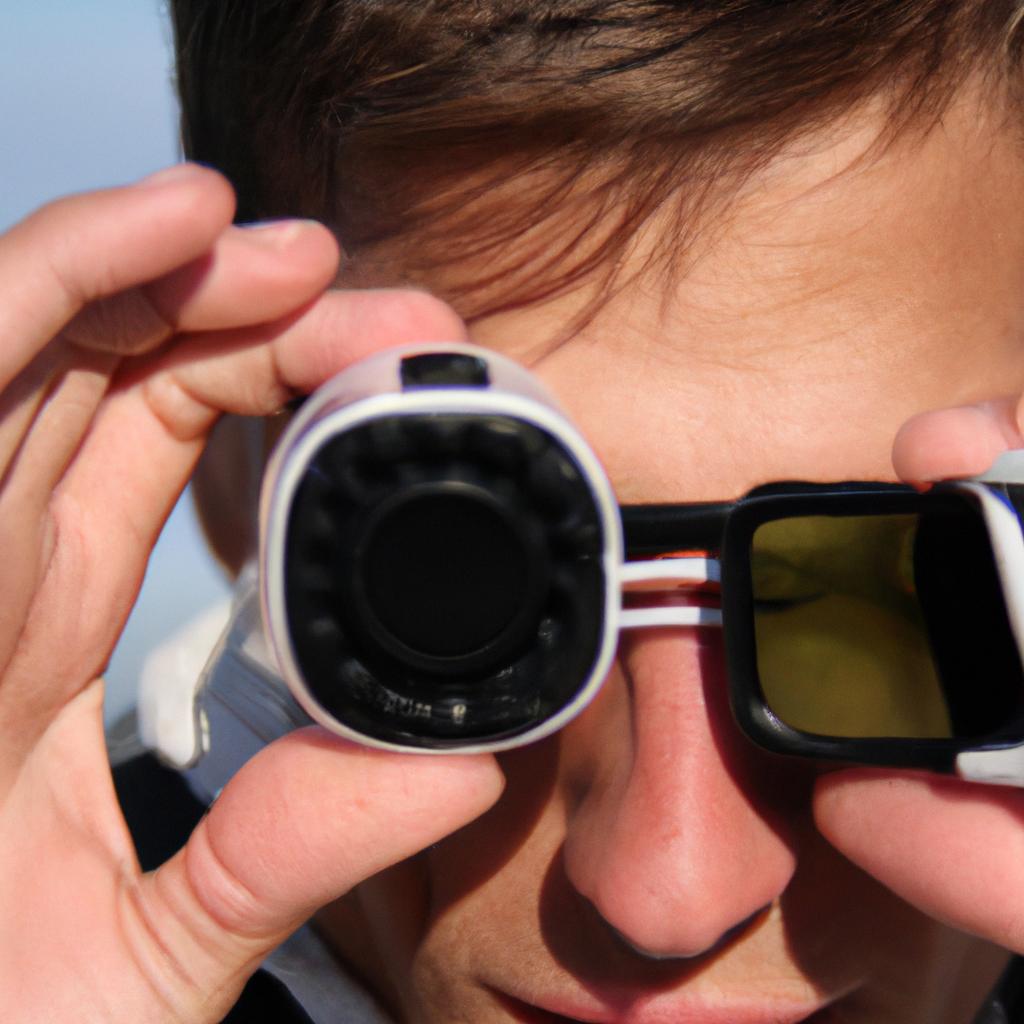Glare Reduction: Sunglasses and the Power of Polarized Lenses

Glare, the excessive brightness caused by reflected light, poses a significant problem for individuals in various environments. Whether it is driving on a sunny day or engaging in outdoor activities like skiing or fishing, glare can impair vision and increase eye strain. One example of this is Sarah, an avid hiker who frequently found herself squinting and struggling to see clearly during her adventures due to intense sunlight reflecting off surfaces such as water or snow. To address this issue, she turned to sunglasses equipped with polarized lenses.
Polarized lenses have gained increasing popularity in recent years due to their ability to effectively reduce glare and enhance visual comfort. Unlike regular sunglasses that merely darken the overall brightness without addressing specific sources of glare, polarized lenses contain a special filter that selectively blocks horizontally oriented light waves. This unique feature allows them to eliminate the majority of reflected glare from horizontal surfaces, significantly improving clarity and reducing eye fatigue. Moreover, unlike other types of lenses that simply reduce brightness uniformly across all wavelengths, polarized lenses maintain color accuracy and contrast while simultaneously providing protection against harmful ultraviolet (UV) rays. As a result, they offer not only enhanced visual acuity but also improved safety when exposed to bright conditions for extended periods.
Understanding Glare: Causes and Effects
Glare, a common phenomenon experienced in daily life, occurs when light is reflected off a surface and causes visual discomfort or impairment. To illustrate this concept, imagine driving on a sunny day with the sun positioned directly in front of you. As sunlight reflects upon the smooth surface of the road, it creates intense glare that hampers your ability to see clearly ahead. This example highlights one of many situations where glare can be problematic.
The intensity of glare can vary depending on several factors. First, the angle at which light strikes a surface plays a crucial role in determining the level of reflection. For instance, when sunlight hits water at an oblique angle, such as during sunrise or sunset, it produces significant glare due to the high reflectance of water surfaces. Similarly, reflective surfaces like glass windows or metal objects can also contribute to pronounced glare.
Secondly, certain environmental conditions exacerbate glare effects. Snow-covered landscapes are notorious for causing blinding glare due to their highly reflective nature. Moreover, foggy weather can scatter light particles and create diffuse sources of illumination, further intensifying visual discomfort associated with glare.
Lastly, different activities require various levels of attention and concentration; therefore, individuals engaged in specific tasks may experience varying degrees of vulnerability to glare-induced distractions. Drivers navigating busy highways rely heavily on clear visibility for safe maneuvering; hence they are particularly susceptible to adverse consequences caused by excessive glare from other vehicles’ headlights.
- Impaired vision leading to accidents
- Discomfort and eye strain
- Reduced productivity in work environments affected by glaring lights
- Potential long-term damage to eyesight if exposed repeatedly over time
Furthermore, we present a table highlighting some everyday scenarios where glare commonly occurs:
| Scenario | Sources | Potential Consequences |
|---|---|---|
| Driving on a sunny day | Sunlight, road surfaces | Reduced visibility and accidents |
| Working in an office | Overhead lights, windows | Eye strain and reduced productivity |
| Outdoor sports activities | Sunlight, water surfaces | Impaired vision and decreased safety |
| Reading near a window | Natural or artificial light reflecting off the glass | Discomfort and difficulty reading |
Understanding the causes and effects of glare is crucial for developing effective strategies to mitigate its negative impacts. In the subsequent section about “How Polarized Lenses Work: Filtering Out Glare,” we will explore how these specialized lenses can help reduce glare by selectively blocking horizontally polarized light waves without compromising overall vision quality.
How Polarized Lenses Work: Filtering Out Glare
Glare Reduction: Sunglasses and the Power of Polarized Lenses
Now that we have explored the causes and effects of glare, let us delve into how polarized lenses work to effectively filter out this nuisance. To illustrate its efficacy, consider a scenario where you are driving on a sunny day, with sunlight bouncing off the surface of the road. As your eyes strain to adapt to the intense brightness, your vision becomes compromised, potentially leading to dangerous situations. This is where polarized lenses come into play.
Polarized lenses employ advanced technology that helps reduce glare by selectively filtering out horizontal light waves, which often cause discomfort and visual distractions. By doing so, these lenses enhance optical clarity and provide a more comfortable viewing experience in bright conditions. The process occurs through a microscopic chemical film embedded within the lens material. This film acts as a vertical filter, allowing only vertically oriented light waves to pass through while blocking horizontally aligned ones.
To better understand the benefits of polarized lenses, here are some key points:
- Improved Visual Comfort: Polarized lenses minimize eyestrain caused by squinting in bright conditions.
- Enhanced Color Perception: These lenses offer sharper contrast and truer colors by reducing scattered light.
- Increased Safety: By eliminating glare from reflective surfaces such as water or shiny objects, they improve visibility for activities like driving or outdoor sports.
- Reduced Eye Fatigue: With reduced glare-induced eye fatigue, wearers can enjoy prolonged periods outdoors without discomfort.
Furthermore, it is essential to note that not all sunglasses come equipped with polarized lenses. When purchasing sunglasses specifically for glare reduction purposes, ensure they explicitly state their polarization feature.
In our next section about “Benefits of Polarized Sunglasses: Clarity and Comfort,” we will explore further advantages provided by polarized sunglasses beyond just glare reduction.
Benefits of Polarized Sunglasses: Clarity and Comfort
Reducing Glare: The Impact of Polarized Sunglasses
Imagine driving on a bright sunny day, when suddenly the sunlight reflects off the shiny surface of the car in front of you, temporarily blinding your vision. This momentary loss of sight can be not only inconvenient but also dangerous. However, with the power of polarized lenses found in sunglasses, such situations can be minimized or even eliminated altogether.
Polarized lenses are designed to filter out glare caused by horizontal light waves bouncing off reflective surfaces like water, snow, glass, and metallic objects. By allowing only vertical light waves to pass through, these lenses significantly reduce brightness and enhance visual clarity. To better understand the benefits of polarized sunglasses, let’s delve into some key advantages they offer:
- Improved Visual Comfort: When wearing polarized sunglasses, users experience reduced eyestrain and fatigue due to decreased glare. The filtering effect enables comfortable viewing by ensuring that our eyes receive uniform levels of light without any harsh reflections.
- Enhanced Color Perception: Not only do polarized lenses reduce glare, but they also improve color contrast and perception. By eliminating unwanted scattered light, they allow us to see colors more vividly and accurately. Whether we’re enjoying outdoor activities or simply going for a walk, this enhanced sense of color adds vibrancy to our surroundings.
- Increased Safety: One significant benefit of using polarized sunglasses is improved safety during various activities. Whether it’s driving, biking, skiing, or engaging in water sports like fishing or boating – reducing glare enhances visibility and helps prevent accidents caused by sudden blindness from reflected light.
- Protection against Harmful UV Rays: Another advantage offered by many polarized sunglasses is their ability to shield our eyes from harmful ultraviolet (UV) rays emitted by the sun. These glasses provide an additional layer of protection beyond regular sunglasses by blocking both UVA and UVB radiation.
To illustrate the impact of polarized sunglasses, consider the following table presenting a comparison between regular sunglasses and those with polarized lenses:
| Regular Sunglasses | Polarized Sunglasses | |
|---|---|---|
| Glare Reduction | Moderate | High |
| Visual Comfort | Limited | Enhanced |
| Color Perception | Standard | Improved |
| UV Protection | Varies by brand | Often offers full protection |
As we can see, polarized sunglasses outperform regular ones in all areas, providing superior glare reduction, enhanced visual comfort, improved color perception, and often offering comprehensive UV protection. By investing in a pair of high-quality polarized sunglasses, individuals can not only enjoy clearer vision but also prioritize their eye health.
Transitioning into our next section about “Choosing the Right Polarized Sunglasses: Factors to Consider,” it is important to note that selecting suitable eyewear goes beyond just considering polarization. Therefore, understanding additional factors will help make an informed decision when purchasing your ideal pair of sunglasses.
Choosing the Right Polarized Sunglasses: Factors to Consider
Reducing glare is a crucial aspect of maintaining visual clarity and comfort while engaging in outdoor activities. In the previous section, we discussed the benefits of polarized sunglasses, highlighting how they enhance both clarity and comfort. Now, let us delve deeper into the factors to consider when choosing the right pair of polarized sunglasses.
Imagine yourself on a bright sunny day, enjoying a leisurely walk along the beach with your family. As you gaze out at the ocean waves crashing against the shore, you notice something peculiar – a significant reduction in glare compared to when you are not wearing sunglasses. This experience illustrates just one example of how polarized lenses can effectively minimize glare by reducing horizontal light reflections that bounce off surfaces like water or shiny objects.
When selecting polarized sunglasses, it is important to take various factors into account. Here are some key considerations:
- Lens Material: Opt for high-quality lens materials such as polycarbonate or Trivex for their durability and impact resistance.
- UV Protection: Ensure that your chosen sunglasses offer 100% protection from harmful ultraviolet (UV) rays.
- Frame Design: Look for frames that fit securely and comfortably on your face, providing proper coverage without obstructing your peripheral vision.
- Style Preferences: Consider personal style preferences as well since finding a pair of polarized sunglasses that suits your tastes will encourage regular use.
To further emphasize these points, let’s examine an emotional bullet point list and table showcasing the advantages of investing in quality polarized sunglasses:
- Enhanced Visual Clarity: Experience sharper images with reduced glare interference.
- Reduced Eye Strain: Minimize eye fatigue caused by extended exposure to intense sunlight.
- Improved Safety: Enhance visibility by eliminating distracting glares while driving or participating in sports activities.
- Long-Term Eye Health Benefits: Protect your eyes from long-term damage caused by prolonged UV exposure.
| Advantages of Quality Polarized Sunglasses |
|---|
| Enhanced Visual Clarity |
| Reduced Eye Strain |
| Improved Safety |
| Long-Term Eye Health Benefits |
Choosing the right pair of polarized sunglasses is essential for optimizing both visual comfort and eye health. In our next section, we will provide valuable tips for maintaining your polarized sunglasses to ensure their longevity and effectiveness. By properly caring for your eyewear, you can continue enjoying the benefits they offer without compromising on performance or protection.
Transitioning into the subsequent section about “Tips for Maintaining Polarized Sunglasses: Care and Cleaning,” it is important to establish a routine that keeps your sunglasses in optimal condition.
Tips for Maintaining Polarized Sunglasses: Care and Cleaning
Reducing glare is one of the primary benefits of wearing polarized sunglasses. By minimizing the amount of reflected light that enters our eyes, these lenses can significantly enhance visual comfort and clarity in various situations. Let us delve deeper into the advantages of using polarized lenses and explore how they can improve your overall visual experience.
Imagine yourself driving on a bright sunny day, navigating through winding roads with water bodies running alongside. Without proper eye protection, the intense glare from the sun bouncing off these reflective surfaces could make it challenging to see clearly and potentially compromise your safety as well as those around you. However, by wearing polarized sunglasses, you can effectively reduce this blinding glare caused by horizontal light waves, enabling better visibility and reducing eye strain.
To further understand the value of polarized lenses, let’s consider some key factors to consider when selecting the right pair:
- Lens Material: Polarized lenses are available in different materials such as glass or polycarbonate. Each material has its own pros and cons regarding durability, weight, optical quality, and impact resistance.
- UV Protection: It is crucial to ensure that your chosen polarized sunglasses provide 100% UVA/UVB protection to shield your eyes against harmful ultraviolet radiation.
- Frame Design: The frame design should be comfortable and fit securely on your face while complementing your personal style preferences.
- Lens Color: Different lens colors offer varying degrees of contrast enhancement for specific activities like fishing or golfing. Choosing a color that suits your needs will optimize your visual performance accordingly.
As we examine the significance of polarized lenses in reducing glare and enhancing vision, it becomes evident why people rely on them for various outdoor activities ranging from sports to leisurely strolls along sandy beaches or snowy mountainsides. To summarize their essential features:
| Key Features |
|---|
| Glare Reduction |
By offering these crucial benefits, polarized sunglasses have become an indispensable accessory for many individuals seeking not only eye protection but also enhanced visual experiences outdoors.
Looking beyond their traditional use in sunglasses, polarized lenses serve various other purposes.
Additional Uses of Polarized Lenses: Beyond Sunglasses
Section H2: Additional Uses of Polarized Lenses: Beyond Sunglasses
Transitioning from the previous section’s discussion on maintaining polarized sunglasses, let us now explore the versatility and wide-ranging applications of polarized lenses. While primarily associated with sunglasses for glare reduction, these specialized lenses have found their way into various other domains due to their remarkable properties.
One notable example is in the field of photography. Professional photographers often utilize polarized filters to enhance image quality by reducing reflections and increasing color saturation. By selectively blocking certain light waves, polarized lenses help capture more vibrant colors while minimizing unwanted glares or reflections on water surfaces, glass windows, or shiny objects. This application allows photographers to achieve stunning visual effects and create captivating images that stand out.
Beyond photography, there are several other practical uses of polarized lenses that can greatly benefit individuals in different settings. Here are some noteworthy examples:
- Outdoor Activities: Polarized lenses prove indispensable for outdoor enthusiasts engaging in activities such as fishing, boating, skiing, or hiking. By eliminating glare from sunlight reflecting off water or snow-covered surfaces, these lenses provide enhanced visibility and reduce eye strain.
- Driving Safety: Glare from the sun or reflective surfaces can pose significant hazards while driving. Polarized lenses effectively minimize this glare, enhancing road visibility and improving overall safety behind the wheel.
- Sports Performance: Athletes participating in sports like golf, tennis, or baseball can experience improved performance with polarized lenses. These lenses optimize vision by reducing distractions caused by bright lights or intense sunlight during gameplay.
- Workplace Applications: In certain professions where employees work outdoors or deal with reflective surfaces regularly (e.g., construction workers, lifeguards), wearing polarized eyewear can significantly improve both comfort and productivity.
To further highlight the diverse uses of polarized lenses beyond sunglasses, consider the following table:
| Application | Benefits |
|---|---|
| Photography | – Reduced reflections on water surfaces, glass windows, or shiny objects |
| Outdoor Activities | – Enhanced visibility and reduced eye strain |
| Driving Safety | – Minimized glare for improved road visibility |
| Sports Performance | – Better focus and reduced distractions from bright lights or intense sunlight during gameplay |
| Workplace Applications | – Increased comfort and productivity in professions involving outdoor work or reflective surfaces |
By recognizing the broader applications of polarized lenses and their ability to improve visual experiences across various contexts, it becomes evident that these lenses have become an invaluable tool beyond just sunglasses. Whether in photography, sports, driving, or workplace settings, the benefits provided by polarized lenses make them a versatile choice for individuals seeking enhanced vision clarity and increased safety.
As we explore further into the world of polarized lenses, it is clear that their impact extends far beyond traditional sunglass use. From professional photographers capturing breathtaking images to athletes maximizing their performance potential, the power of polarized lenses cannot be understated. Embracing these specialized lenses opens up a realm of possibilities where visual quality and comfort converge seamlessly.





